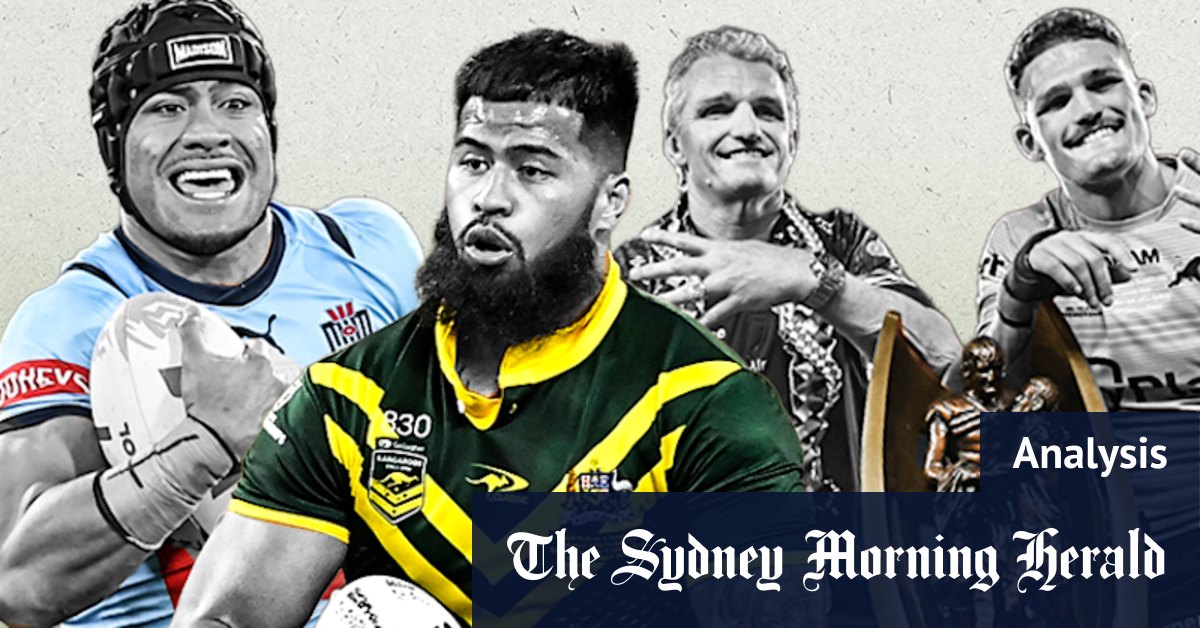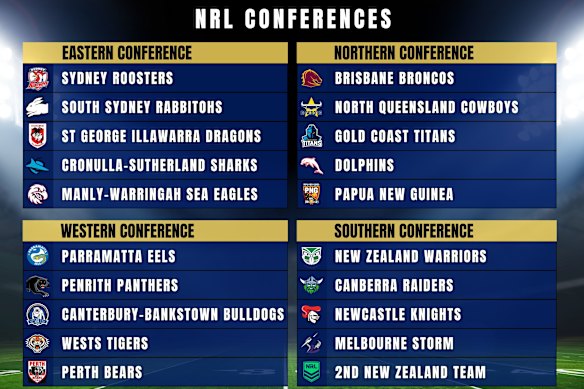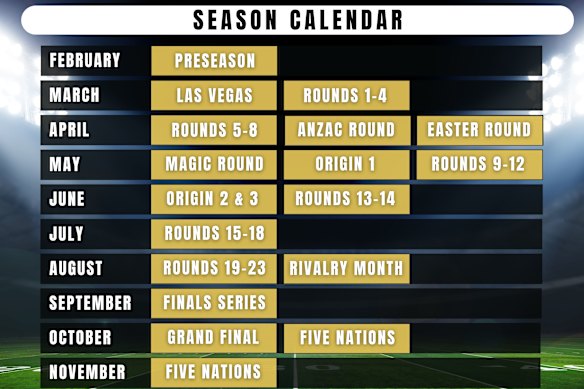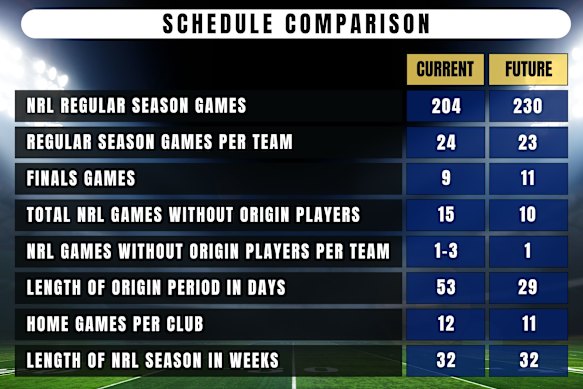Conferences, mid-week games and 10-team finals: How a 20-team NRL competition could work
The NRL is on the verge of major change with the introduction of two teams in the next three years. A third team by as early as 2030 will take the competition to 20 teams. What will that look like?
By
Michael Chammas
August 1, 2025
Save
Share
Normal text sizeLarger text sizeVery large text size
3
T
he NRL has started sitting down with potential broadcast partners to open discussions about the future of the sport. With a team in Perth entering the competition in 2027 and a team in Papua New Guinea the following year, the NRL is just one team away from reaching its desired 20-team competition. That could come as early as 2030. This masthead has spoken to the key stakeholders in the sport to map out what a 20-team competition could look like, including the introduction of conferences and a change to the State of Origin period.
Conferences
There has been considerable debate in recent years about the NRL transitioning to a conference-based system, similar to those of several major American sports.
In a 20-team competition, there are two viable options. One option is to split the competition into two 10-team conferences.
What the conferences could look like.Credit:SMH
That model, however, raises issues with the number of games played in a regular season. If teams played the other teams in their conference twice, and the other conference once, the competition would be extended from 24 to a 28-game season. That’s never happening.
The model posed by this masthead is based on a four-conference system consisting of five teams in each conference.
Advertisement
That allows teams to play each other once (19 rounds), then a rivalry month leading into the finals series, when teams square off against their conference opponents for the second leg of their home-and-away fixtures.
The current draw sees some teams play opponents twice, with no formula or fairness behind the selections.
The major scheduling talking points of a 20-team competition.Credit:SMH
“Twenty teams is the right number,” ARL Commission chairman Peter V’landys said.
“It’s just a matter of when and how we can get there. We want to ensure the first two teams are successful. The Dolphins were successful. We want to make sure the Perth Bears and PNG are equally successful. That might bring the 20th team forward. The success of the two teams will determine how quickly we can move to a 20-team comp.
“Conferences done correctly, yeah, absolutely, I like it. When I first started as chairman, I had a delegation of high-profile coaches and administrators. They wanted conferences, so I’ve always had it in the back of my head. Tribalism is the main ingredient in our sport.”
With nine Sydney teams, it makes it difficult to place them into two clear conferences. By placing the “Big Six” Sydney teams in terms of fan bases and history (Roosters, Dragons, Rabbitohs, Bulldogs, Tigers and Eels) into two separate groups, you ensure more blockbuster games for broadcasters and fans.
Advertisement
“It’ll be great for the gate,” Roosters chairman Nick Politis recently said.
“Playing the Sydney teams twice is better for us than playing the Titans or Dolphins at home. Revenue will go through the roof. You’ll get better crowds. It’s fair.
“We get back to playing a proper draw, not all over the place like it is now. That’s fairness. Now, the top clubs play each other twice, and the bottom teams play each other twice, and we end up somewhere in the middle and get a close comp. Everyone says we’re geniuses, but we’re not. It’s engineered.”
Eastern conference: Sydney Roosters, South Sydney Rabbitohs, St George Illawarra Dragons, Cronulla Sharks and Manly Sea Eagles.
Western conference: Parramatta Eels, Canterbury Bulldogs, Wests Tigers, Penrith Panthers and Perth Bears.
This masthead placed the Perth Bears into a Sydney conference due to their North Sydney fan base. Placing them in another conference with teams like the Warriors, Cowboys or Papua New Guinea will only add to the extensive travel those teams will undertake. The 20th team has also been given to a second New Zealand team.
Advertisement
“I wouldn’t want another team in New Zealand, I would want another southern Queensland team,” former Channel Nine boss David Gyngell said.
“That would drive broadcast and Pay TV revenue for all parties. Ten games aren’t easy to schedule each week, but achievable. There are exciting times ahead for rugby league.
Northern conference: Brisbane Broncos, Gold Coast Titans, North Queensland Cowboys, Dolphins and Papua New Guinea.
Southern conference: Melbourne Storm, Canberra Raiders, Warriors, Newcastle Knights and a potential second NZ-based team.
“Peter and Andrew have our complete support and confidence as they go into these broadcast negotiations,” South Sydney chief executive Blake Solly said.
“We know they’re concentrating on the most compelling competition they can and getting full value for our broadcast rights. One of the great things about the conference system is the certainty it provides you year in, year out.
The NRL could be in for huge changes.Credit:Getty/Michael Howard
Advertisement
“Particularly the opportunity to build strong rivalries inside your conference. Anyone who has an interest in the NFL knows how passionate those rivalries can be in the conference and how much fans look forward to the fact they are taking place home and away every year.”
While the teams in the southern conference would be required to travel further distances than the teams in the Sydney conferences, it is no more travel than they are currently being asked to undertake.
“We would need convincing as an out-of-town club whether a conference system would be good or not,” Raiders chief executive Don Furner said in fear of the disadvantage of the additional travel.
How a 10-game round television schedule may look.Credit:SMH
Length of season
Most would agree that the current NRL season, at 24 games with three byes, is too long. However, broadcasters pay top dollar for a product that provides commercial partners a substantial window of promotion.
The same goes with the clubs, who would be significantly impacted by a draw that would only see teams play each other once (19 rounds).
Advertisement
The Rugby League Players’ Association believes a 19-20 game regular season is an optimal amount to reduce the workload on players and minimise injuries.
“The season schedule has desperately needed serious innovation for years, and we are and have always been up for that discussion,” RLPA chief executive Clint Newton said.
“With a new broadcast deal approaching, we’ve got the best chance in a long time to stop patching problems and start building something progressive and transformative, but sustainable.
“Fewer games per NRL club, a better-aligned Origin period, and a genuine international window. If we get those right, we can deliver the content broadcasters need, grow the game globally, and better protect players’ welfare and careers.”
Clubs are mindful, however, that reducing the season to 19-20 games will impact their corporate revenue, sponsorship deals and the income from tickets and membership.
“I understand the need to protect the players and the increasing demands of the game, but that would be a major change from where we are right now,” Eels chief executive Jim Sarantinos said.
The proposed NRL calendar.Credit:SMH
“Reducing the number of home games for each club from 12 to 9 would have a significant impact on how clubs engage with fans, members and sponsors, and the business model across the whole game would need to change.”
There are currently 204 games in the NRL regular season. Even if the competition is reduced by one round, the NRL will increase the number of regular-season games to 230 (13 per cent increase) with the addition of two extra games per round with the new teams.
“Personally, I’d like to see the season shorter,” Furner said.
“It’s such a long season with rep football and trial matches. If there was a way to satisfy the broadcasters with less NRL games, that would be an ideal outcome. I look at the amount of games in the NFL, and it works for them.”
Comparing the difference between the current season structure and what it would be like under the proposed 20-team, four-conference system.Credit:SMH
Finals format
It’s imperative to place a greater importance on conference rivalry games. Incentivising the conference champion will only add to the spectacle of some of the blockbuster matches.
The reward for the highest-ranked team in each conference (based on the overall ladder) is a direct pathway into the finals series.
Those teams would be seeded from 1-4 based on the best overall win/loss record throughout the season.
That would guarantee the conference champion a second chance if they lose their opening game of the finals. Those teams, based on the current NRL ladder after 21 rounds, would be the Raiders, Bulldogs, Broncos and Sharks.
The other six teams would be seeded from 5-10 in order of their overall standing on the combined ladder.
In the first week of the finals, 7th would play 10th and 8th would play 9th for the right to progress into the final eight the following week.
Teams 1-6 would be given the week off in the first week of the finals. This would help negate the current situation, which sees many teams resting their players in the final round of the regular season to prepare for the finals at the expense of the integrity of the competition.
The 10-team finals series format based on the 2025 calendar.Credit:SMH
The opening weekend of the finals would determine the two teams that would join the remaining six teams in week two of the finals. From that point, the current top eight finals system would be applied.
It gives broadcasters an additional two sudden-death finals games to sell to commercial partners and provides the game with an uplift in attendance and television viewers.
By reducing the regular season by one round and extending the finals series by one week, the NRL grand final will remain on the October long weekend.
“I used to think the ideal model was to split the competition into two conferences and have your Sydney grand final and out-of-Sydney grand final, with the two teams playing in some sort of Super Bowl,” South Sydney coach Wayne Bennett said.
“Once we get to 20 teams, there will be too many teams for that. Maybe the four conference system is the way to go because we need more rivalry games.”
State of Origin period
The television ratings speak to the beast that is State of Origin, but often the representative fixture comes at the detriment of the NRL competition.
Clubs pay their premium players top dollar, only to lose some of them to State of Origin, often picking up injuries or returning both physically and mentally fatigued.
Queensland celebrate winning this year’s State of Origin series.Credit:Getty Images
“Currently, it’s the worst model we can have,” Bennett said.
“It’s the timing of it and how it least impacts the clubs. One of the great fallacies of our game is that the best team doesn’t always win the grand final. Not every season, but Origin has impacted on the finals and the premiers. I laugh because I’ve coached all these years and with a high number of Origin players in my teams.
“I’m qualified to tell you how much it takes a toll. I have no doubt we should have gone back-to-back premierships at the Dragons, but Origin killed us. When the players came back they were physically drained and mentally shot after a brutal series. We never recovered from that.”
Wayne Bennett with players Jamie Soward and Dean Young at the Dragons after the 2010 grand final win.Credit:Getty
State of Origin belongs in the middle of the season, but does it have to last so long? Does it have to have such a significant impact on the NRL teams?
There are currently 53 days between when the players arrive in camp for game one and when they leave after game three.
They do return to their clubs in between matches, but the NRL can’t continue to allow Origin to have such a major impact on clubs.
“The Origin schedule is a bit like Frankenstein’s monster,” Solly said.
“The NRL competition provides the ARLC with 90 per cent of its revenue, yet a three-game series disrupts it for almost 30 per cent of it. No other premier sporting club competition would accept that disruption. People at the NFL, the NBA, the Premier League think we clubs are mad in accepting that position.
Payne Haas was on light duties leading into all three Origin games this year.Credit:Getty Images
“The current Origin window is a complete disaster for clubs. It takes our best players away too often and for too long. We understand that this current system was a product of this TV cycle.”
“We much preferred the Wednesday-Sunday-Wednesday schedule of the previous system, and we’ve been vocal in seeking change from the NRL. We respect that Andrew and Peter can’t do anything in this cycle, but everyone in the game wants a shorter Origin period with less disruption to the NRL competition.”
How the State of Origin period would work, based on the 2025 calendar.Credit:SMH
Under the model proposed, the Origin period would be reduced from 53 days to 29.
Players would remain in camp for the duration of the series, playing the first game on a Wednesday, the second game 10 days later on a Sunday, and the third 10 days later on a Wednesday.
“I would debate the duration of the State of Origin as that’s a critical component,” Gyngell said.
The model proposed would see NRL clubs lose Origin players for just one game each.
Split rounds and mid-week matches, similar to the English Premier League over the Christmas period, would give broadcasters an 18-day footy festival each May (combination of NRL games, men’s Origin, women’s Origin, under 19’s Origin and under 21 Test matches involving Australia, New Zealand, Tonga and Samoa).
“I think the system we have now is working,” NSWRL boss Dave Trodden said.
“I think under any model that will be satisfactory for the broadcasters, there’ll be a consequence to the clubs. The most important consideration is going to be what the broadcasters think of the schedule.
“State of Origin drives so much of the commercial value in the broadcast deal, so that will be in the minds of the decision makers. With the massive ratings they have been getting the last couple of years, broadcasters will be reluctant to mess around with the schedule too much.”
The proposed changes would ensure Origin players remain in camp throughout the series, negating the risk of injuries suffered when returning to club land and continually building on the hype of the series without the stoppages that currently exist.
“As long as the solution doesn’t compromise the quality of the product, because Origin is so big and so unique, it needs to be taken into account,” Queensland Rugby League boss Ben Ikin said.
“But more importantly, as long as the rules that they change advantage Queensland and not NSW, we’ll be fine.”
International window
Like the Six Nations in European rugby union, there is an opportunity to build an annual competition that helps grow the international game.
A Five Nations tournament involving England, Australia, Samoa, Tonga and New Zealand would be played each year (non World Cup years) over five weeks, starting a fortnight after the grand final.
The proposed Five Nations tournament.Credit:SMH
The annual leave entitlements of the players would prohibit the competition running longer than five weeks (mid-November), therefore, the winner of the Five Nations would be determined by the ladder and not a final.
“Because of the club’s success we’ve gone deep into the year, and that has been compounded by representative player selection,” Panthers rugby league chief executive Matt Cameron said.
“Although we’re really proud of this success, it does put pressure on the preseason time frame and any future model that would help alleviate these pressures would certainly be a benefit to all clubs.”







